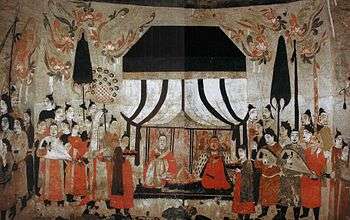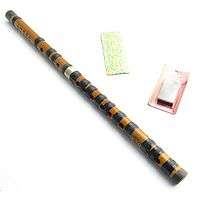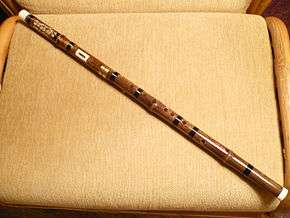List of Chinese musical instruments
| Music of China | |
|---|---|
 | |
| General topics | |
| Genres | |
| Specific forms | |
| Media and performance | |
| Music festivals | Midi Modern Music Festival |
| Music media | |
| Nationalistic and patriotic songs | |
| National anthem | |
| Regional music | |
This is an introduction to and list of traditional Chinese instruments.
The Eight Sounds or Eight Tones
Chinese musical instruments were traditionally classified into 8 categories known as bayin (八音).[1] The eight categories are: silk, bamboo, wood, stone, metal, clay, gourd and skin. There are other instruments which may not fit these classifications. This is one of the first musical classifications ever devised.
Silk (絲)
Silk instruments are mostly stringed instruments (including those that are plucked, bowed, and struck). Since ancient times the Chinese have used twisted silk for strings, though today metal or nylon are more frequently used. Instruments in the silk category include:
Plucked
- Guqin (Chinese: 古琴; pinyin: gǔqín) – 7-stringed zither
- Se (Chinese: 瑟; pinyin: sè) – 25-stringed zither with movable bridges (ancient sources say 13, 25 or 50 strings)
- Guzheng (古箏) – 16–26 stringed zither with movable bridges
- Konghou (箜篌) – harp
- Pipa (琵琶) – pear-shaped fretted lute with 4 or 5 strings
- Sanxian (三弦) – plucked lute with body covered with snakeskin and long fretless neck
- Ruan (Chinese: 阮; pinyin: ruǎn) – moon-shaped lute in five sizes: gaoyin-, xiao-, zhong-, da-, and diyin-; sometimes called ruanqin (阮琴)
- Liuqin (柳琴) – small plucked, fretted lute with a pear-shaped body and four strings
- Yueqin (月琴) – plucked lute with a wooden body, a short fretted neck, and four strings tuned in pairs
- Qinqin (秦琴) – plucked lute with a wooden body and fretted neck; also called meihuaqin (梅花琴, literally "plum blossom instrument", from its flower-shaped body)
- Duxianqin (simplified Chinese: 独弦琴; traditional Chinese: 獨弦琴) – the instrument of Jing People (Vietnamese people in China) plucked zither with only one string a monochord zither tuned to c3.
- wenqin 文琴 a combonation of the erhu , konghou , sanxian and gusheng with 50 or more strings made of silk.
- wenzhenqin 文枕琴 a zither with 25 or more string either plucked or bowed
Bowed

- Huqin (胡琴) – family of vertical fiddles
- Erhu (二胡) – two-stringed fiddle
- Zhonghu (中胡) – two-stringed fiddle, lower pitch than erhu
- Gaohu (高胡) – two-stringed fiddle, higher pitch than erhu; also called yuehu (粤胡)
- Banhu (板胡) – two-stringed fiddle with a coconut resonator and wooden face, used primarily in northern China
- Jinghu (京胡) – two-stringed fiddle, very high pitched, used mainly for Beijing opera
- Jing erhu (京二胡) – erhu used in Beijing opera
- Erxian (二弦) – two-stringed fiddle, used in Cantonese, Chaozhou, and nanguan music
- Tiqin (提琴) – two-stringed fiddle, used in kunqu, Chaozhou, Cantonese, Fujian, and Taiwanese music
- Yehu (椰胡) – two-stringed fiddle with coconut body, used primarily in Cantonese and Chaozhou music
- Daguangxian (大广弦) – two-stringed fiddle used in Taiwan and Fujian, primarily by Min Nan and Hakka people; also called datongxian (大筒弦), guangxian (广弦), and daguanxian (大管弦)
- Datong (大筒) – two-stringed fiddle used in the traditional music of Hunan
- Kezaixian (壳仔弦) – two-stringed fiddle with coconut body, used in Taiwan opera
- Liujiaoxian (六角弦) – two-stringed fiddle with hexagonal body, similar to the jing erhu; used primarily in Taiwan
- Tiexianzai (鐵弦仔) – a two-stringed fiddle with metal amplifying horn at the end of its neck, used in Taiwan; also called guchuixian (鼓吹弦)
- Hexian (和弦) – large fiddle used primarily among the Hakka of Taiwan
- Huluqin (葫芦琴) – two-stringed fiddle with gourd body used by the Naxi of Yunnan
- Huluhu (simplified Chinese: 葫芦胡; traditional Chinese: 葫盧胡) – two-stringed fiddle with gourd body used by the Zhuang of Guangxi
- Maguhu (simplified Chinese: 马骨胡; traditional Chinese: 馬骨胡; pinyin: mǎgǔhú) – two-stringed fiddle with horse bone body used by the Zhuang and Buyei peoples of southern China
- Tuhu (土胡) – two-stringed fiddle used by the Zhuang people of Guangxi
- Jiaohu (角胡) – two-stringed fiddle used by the Gelao people of Guangxi, as well as the Miao and Dong
- Sihu (四胡) – four-stringed fiddle with strings tuned in pairs
- Sanhu (三胡) – 3-stringed erhu with an additional bass string; developed in the 1970s
- Zhuihu (simplified Chinese: 坠胡; traditional Chinese: 墜胡) – two-stringed fiddle with fingerboard
- Zhuiqin (traditional: 墜琴; simplified: 坠琴) – two-stringed fiddle with fingerboard
- Leiqin (雷琴) – two-stringed fiddle with fingerboard
- Dihu (低胡) – low pitched two-stringed fiddles in the erhu family, in three sizes:
- Xiaodihu (小低胡) – small dihu, tuned one octave below the erhu
- Zhongdihu (中低胡) – medium dihu, tuned one octave below the zhonghu
- Dadihu (大低胡) – large dihu, tuned two octaves below the erhu
- Dahu (大胡) – another name for the xiaodihu
- Cizhonghu – another name for the xiaodihu
- Gehu (革胡) – four-stringed bass instrument, tuned and played like cello
- Diyingehu (低音革胡) – four stringed contrabass instrument, tuned and played like double bass
- Laruan (拉阮) – four-stringed bowed instrument modeled on the cello
- Paqin (琶琴) – modern bowed instrument
- Dapaqin (大琶琴) – bass paqin
- Dixianqin (低絃琴)-also called yihu (一胡) a bowed monochord zither
- Niutuiqin or niubatui (牛腿琴 or 牛巴腿) – two-stringed fiddle used by the Dong people of Guizhou
- Matouqin (馬頭琴) – (Mongolian: morin khuur) – Mongolian two-stringed "horsehead fiddle"
- Xiqin (奚琴) – ancient prototype of huqin family of instruments
- Yazheng (simplified: 轧筝; traditional: 軋箏) – bowed zither; also called yaqin (simplified: 轧琴; traditional: 軋琴)
- Zhengni (筝尼) – bowed zither; used by the Zhuang people of Guangxi
- Ghaychak (艾捷克) – four-stringed bowed instrument used in Xinjiang; similar to kamancheh
- Sataer (萨它尔) – long-necked bowed lute used in Xinjiang
Struck
- Yangqin (揚琴) - hammered dulcimer
- Zhu (筑) - a guqin played with a bamboo plectrum
- Niujinqin (牛筋琴) - a zither played with a mallet used to accompany traditional narrative singing in Wenzhou, Zhejiang province, China
Bamboo (竹)

Bamboo mainly refers to woodwind instruments, which includes;
Flutes
- Dizi (笛子) - transverse bamboo flute with buzzing membrane
- Bangdi (梆笛)
- Xiao (simplified Chinese: 箫; traditional Chinese: 簫; pinyin: xiāo) - end-blown flute; also called dongxiao (simplified Chinese: 洞箫; traditional Chinese: 洞簫)
- Paixiao (simplified Chinese: 排箫; traditional Chinese: 排簫; pinyin: páixiāo) - pan pipes
- Chi (篪; pinyin: chí) - ancient transverse bamboo flute
- Yue (籥; pinyin: yuè) - ancient notched vertical bamboo flute with three finger holes; used in Confucian ritual music and dance
- Xindi (新笛) - modern transverse flute with as many as 21 holes
- Dongdi (侗笛) - wind instrument of the Dong people of southern China
- Koudi (口笛; pinyin: kǒudí) - very small transverse bamboo flute
Free reed pipes
- Bawu (simplified Chinese: 巴乌; traditional Chinese: 巴烏; pinyin: bāwū) - side-blown free reed pipe with finger holes
- Mangtong (芒筒; pinyin: mángtǒng) - end-blown free reed pipe producing a single pitch
- Miaozu di (Chinese: 苗族笛; pinyin: miáozú dí
Single reed pipes
Double reed pipes
- Guan (Chinese: 管; pinyin: guǎn) - cylindrical double reed wind instrument made of either hardwood (Northern China) or bamboo (Cantonese); the northern version is also called guanzi (管子) or bili (traditional: 篳篥; simplified: 筚篥), the Cantonese version is also called houguan (喉管), and the Taiwanese version is called 鸭母哒仔, 鴨母笛, or Taiwan guan (台湾管)
- Suona (simplified Chinese: 唢呐; traditional Chinese: 嗩吶) - double-reed wind instrument with a flaring metal bell; also called haidi (海笛)
Wood (木)
Most wood instruments are of the ancient variety:
- Zhu (Chinese: 柷; pinyin: zhù) – a wooden box that tapers from the top to the bottom, played by hitting a stick on the inside, used to mark the beginning of music in ancient ritual music
- Yu (Chinese: 敔; pinyin: yǔ) – a wooden percussion instrument carved in the shape of a tiger with a serrated back, played by hitting a stick with an end made of approximately 15 stalks of bamboo on its head three times and across the serrated back once to mark the end of the music
- Muyu (simplified Chinese: 木鱼; traditional Chinese: 木魚; pinyin: mùyú) – a rounded woodblock carved in the shape of a fish, struck with a wooden stick; often used in Buddhist chanting
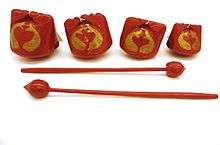
- Paiban (拍板) – a clapper made from several flat pieces of wood; also called bǎn (板), tánbǎn (檀板), mùbǎn (木板), or shūbǎn (书板); when used together with a drum the two instruments are referred to collectively as guban (鼓板)
- Zhuban (竹板, a clapper made from two pieces of bamboo)
- Chiban (尺板)
- Bangzi (梆子) – small, high-pitched woodblock; called qiaozi (敲子) or qiaoziban (敲子板) in Taiwan
- Nan bangzi (南梆子)
- Hebei bangzi (河北梆子)
- Zhui bangzi (墜梆子)
- Qin bangzi (秦梆子)
Stone (石)
The "stone" category comprises various forms of stone chimes.
- Bianqing (simplified Chinese: 编磬; traditional Chinese: 編磬; pinyin: biānqìng) – a rack of stone tablets that are hung by ropes from a wooden frame and struck using a mallet
- Tezhong (特鐘) – a single large stone tablet hung by a rope in a wooden frame and struck using a mallet
- Sounding stone or Qing (磬)
Metal (金)
- Bianzhong (編鐘) – 16 to 65 bronze bells hung on a rack, struck using poles
- Fangxiang (simplified Chinese: 方响; traditional Chinese: 方響; pinyin: fāngxiǎng; Wade–Giles: fang hsiang) – set of tuned metal slabs (metallophone)
- Nao (musical instrument) (鐃) – may refer to either an ancient bell or large cymbals
- Shangnao (商鐃) – ancient bellphoto
- Bo (鈸; also called chazi, 镲子) –
- Xiaobo (小鈸, small cymbals)
- Zhongbo (中鈸, medium cymbals; also called naobo (鐃鈸) or zhongcuo
- Shuibo (水鈸, literally "water cymbals")
- Dabo (大鈸, large cymbals)
- Jingbo (京鈸)
- Shenbo (深波) – deep, flat gong used in Chaozhou music; also called gaobian daluo (高边大锣)
- Luo (simplified Chinese: 锣; traditional Chinese: 鑼; pinyin: luó) – gong
- Daluo (大锣) – a large flat gong whose pitch drops when struck with a padded mallet
- Fengluo (风锣) – literally "wind gong," a large flat gong played by rolling or striking with a large padded mallet
- Xiaoluo (小锣) – a small flat gong whose pitch rises when struck with the side of a flat wooden stick
- Yueluo (月锣) – small pitched gong held by a string in the palm of the hand and struck with a small stick; used in Chaozhou music
- Jingluo (镜锣) – a small flat gong used in the traditional music of Fujian
- Pingluo (平锣) – a flat gong[5]
- Kailuluo (开路锣)
- Yunluo (simplified Chinese: 云锣; traditional Chinese: 雲鑼) – literally "cloud gongs"; 10 or more small tuned gongs in a frame
- Shimianluo (十面锣) – 10 small tuned gongs in a frame
- Qing (磬) – a cup-shaped bell used in Buddhist and Daoist ritual music
- Daqing (大磬) – large qing
- Pengling (碰铃; pinyin: pènglíng) – a pair of small bowl-shaped finger cymbals or bells connected by a length of cord, which are struck together
- Dangzi (铛子) – a small, round, flat, tuned gong suspended by being tied with silk string in a round metal frame that is mounted on a thin wooden handlephoto; also called dangdang (铛铛)
- Yinqing (引磬) – an inverted small bell affixed to the end of a thin wooden handlephoto
- Yunzheng (云铮) – a small flat gong used in the traditional music of Fujian
- Chun (錞; pinyin: chún) – ancient bellphoto
- Bronze drum (铜鼓)
- Laba (喇叭) – A long, straight, valveless brass trumpet
Clay (土)
- Xun (埙, Chinese: 塤; pinyin: xūn) – ocarina made of baked clay
- Fou (Chinese: 缶; pinyin: fǒu) – clay pot played as a percussion instrument
Gourd (匏)
- Sheng (Chinese: 笙; pinyin: shēng) – free reed mouth organ consisting of varying number of bamboo pipes inserted into a metal (formerly gourd or hardwood) chamber with finger holes
- Baosheng (抱笙) – larger version of the Sheng
- Yu (Chinese: 竽; pinyin: yú) – ancient free reed mouth organ similar to the sheng but generally larger
- He (Chinese: 和; pinyin: he) – ancient free reed mouth organ similar to the sheng but smaller
- Hulusi (simplified Chinese: 葫芦丝; traditional Chinese: 葫蘆絲; pinyin: húlúsī) – free-reed wind instrument with three bamboo pipes which pass through a gourd wind chest; one pipe has finger holes and the other two are drone pipes; used primarily in Yunnan province
- Hulusheng (simplified Chinese: 葫芦笙; traditional Chinese: 葫蘆笙; pinyin: húlúshēng) – free-reed mouth organ with a gourd wind chest; used primarily in Yunnan province
Skin (革)
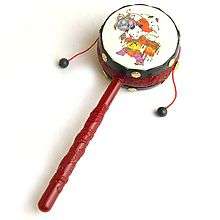
- Dagu – (大鼓) – large drum played with two sticks
- Huzuo Dagu (虎座大鼓)
- Huzuo Wujia Gu (虎座鳥架鼓)
- Jian'gu (建鼓)
- Bangu (板鼓) – small, high pitched drum used in Beijing opera; also called danpigu (单皮鼓)
- Biangu (扁鼓) – flat drum, played with sticks
- Paigu (排鼓) – set of three to seven tuned drums played with sticks
- Tanggu (堂鼓) – medium-sized barrel drum played with two sticks; also called tonggu (同鼓) or xiaogu (小鼓)
- Biqigu (荸荠鼓) – a very small drum played with one stick, used in Jiangnan sizhu
- Diangu (点鼓; also called huaigu, 怀鼓) – a double-headed frame drum played with a single wooden beater; used in the Shifangu ensemble music of Jiangsu province and to accompany to kunqu opera
- Huagu (花鼓) – flower drum
- Yaogu (腰鼓) – waist drum
- Taipinggu (太平鼓) – flat drum with a handle; also called dangu (单鼓)
- Zhangu (战鼓 or 戰鼓) – war drum; played with two sticks
- Bajiao gu (八角鼓) – octagonal tambourine used primarily in narrative singing from northern China zh:八角鼓
- Yanggegu (秧歌鼓) – rice planting drum
- Gaogu (鼛鼓) – large ancient drum used to for battlefield commands and large-scale construction
- Bofu (搏拊) – ancient drum used to set tempo
- Jiegu (羯鼓) – hourglass-shaped drum used during the Tang Dynasty
- Tao (鼗; pinyin: táo) or taogu (鼗鼓) – a pellet drum used in ritual music
- Bolang Gu (波浪鼓;pinyin: bo lang gu) – a traditional Chinese pellet drum and toy
Others
- Gudi (骨笛) – an ancient flute made of bone[7]
- Hailuo (海螺) – conch shell
- Lilie (唎咧) – reed wind instrument with a conical bore played by the Li people of Hainan
- Lusheng (simplified Chinese: 芦笙; traditional Chinese: 蘆笙; pinyin: lúshēng) – free-reed mouth organ with five or six pipes, played by various ethnic groups in southwest China and neighboring countries
- Kouxian (口弦) – jaw harp, made of bamboo or metal
- Muye (木叶) – tree leaf used as a wind instrument
Playing contexts
Chinese instruments are either played solo, collectively in large orchestras (as in the former imperial court) or in smaller ensembles (in teahouses or public gatherings). Normally, there is no conductor in traditional Chinese music, nor any use of musical scores or tablature in performance. Music was generally learned aurally and memorized by the musician(s) beforehand, then played without aid. As of the 20th century, musical scores have become more common, as has the use of conductors in larger orchestral-type ensembles.
Musical instruments in use in the 1800s
These watercolour illustrations, made in China in the 1800s, show several types of musical instruments being played:
 Woman playing a dizi.
Woman playing a dizi. Woman playing a jinghu.
Woman playing a jinghu. Woman playing a luo.
Woman playing a luo. Woman playing a pipa.
Woman playing a pipa. Woman playing a sanxian.
Woman playing a sanxian.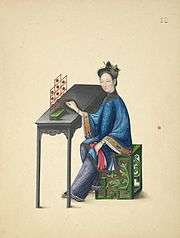 Woman playing a shimianluo.
Woman playing a shimianluo. Woman playing a xiaoluo.
Woman playing a xiaoluo. Woman playing a wind instrument with a curved bell.
Woman playing a wind instrument with a curved bell. Woman playing a xiao.
Woman playing a xiao. Woman playing what looks like a yangqin or some sort of psaltery-like instrument.
Woman playing what looks like a yangqin or some sort of psaltery-like instrument.
See also
- Music of China
- Traditional Korean musical instruments
- Chinese art
- Chinese instrument classification
- List of ensemble formations in traditional Chinese music
References
- Notes
- ↑ Don Michael Randel, ed. (2003). The Harvard Dictionary of Music (4th ed.). Harvard University Press. pp. 260–262. ISBN 978-0674011632.
- ↑ Patricia Ebrey (1999), Cambridge Illustrated History of China, Cambridge: Cambridge University Press, p. 148.
- ↑ Chinese Instrument Dizi
- ↑ Bawu Wikipage
- ↑ photo
- ↑ Chinese Musical Instrument-Bolanggu
- ↑ Endymion Wilkinson (2000), Chinese history, ISBN 978-0-674-00249-4
- Sources
- Lee, Yuan-Yuan and Shen, Sinyan. Chinese Musical Instruments (Chinese Music Monograph Series). 1999. Chinese Music Society of North America Press. ISBN 1-880464-03-9
- Shen, Sinyan. Chinese Music in the 20th Century (Chinese Music Monograph Series). 2001. Chinese Music Society of North America Press. ISBN 1-880464-04-7
- Yuan, Bingchang, and Jizeng Mao (1986). Zhongguo Shao Shu Min Zu Yue Qi Zhi. Beijing: Xin Shi Jie Chu Ban She/Xin Hua Shu Dian Beijing Fa Xing Suo Fa Xing. ISBN 7-80005-017-3.
External links
- Chinese musical instruments
- Chinese Musical Instruments Leisure and Cultural Services Department, Hong Kong
- Chime A look at ancient Chinese instruments
- Chinese musical instruments (Chinese)
- Chinese Instruments Website (English)
- Chinese musical instruments
- The Musical Instruments E-book
- World of Instrumental Music
- The Grand Chinese New Year Concert
- Chinese Instrument
- Chinese Musical Instruments (The Modern Appearance)
